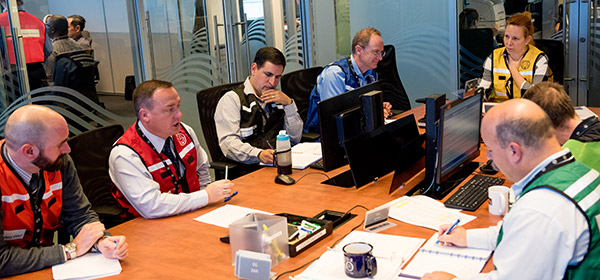Emergency management and nuclear security – Who does what
Who does what during a nuclear emergency?
The CNSC is the federal nuclear regulator that licenses nuclear power plants in Canada and monitors their safe operation.
The operator of the power plant and provincial and federal authorities work together to provide the public with the information it needs during a nuclear emergency.
| Organization | Responsibilities during a nuclear emergency |
|---|---|
| Nuclear power plant operator |
|
| Canadian Nuclear Safety Commission |
|
| Provincial authority (provincial and municipal governments, emergency responders) |
|
In the unlikely event of an accident at a major nuclear facility, such as a nuclear power plant, many different groups would be involved in the response.
At the nuclear power plant, the plant operator is the lead for responding to the incident at the power plant, referred to as onsite response. The province and local authorities would be the lead in responding to the needs of the surrounding community, referred to as offsite response.
During an emergency, the CNSC provides regulatory oversight of the actions being taken by the licensee to protect the public, the workers and the environment.
Federal government departments can also be called upon to support the efforts led by provincial and local authorities.
- Onsite response
- Offsite response
- CNSC role
- CNSC Emergency Operation Center
- Exercises
- Support from federal departments
Onsite response
The licensee is in charge of responding to the situation at the nuclear power plant. In the unlikely event of a nuclear accident, they are responsible for stopping the accident's progression and minimizing any impacts to the surrounding communities.
The licensee also supports provincial and local authorities in their response efforts. For example, the licensee must provide clear up-to-date information and technical support to provincial and local authorities to help them in their response.
The CNSC oversees the licensee's response to the event. In particular, the CNSC ensures that the licensee does everything it can to minimize radioactive releases and protect the public and environment.
Offsite response
Provincial and local authorities (e.g., provincial and municipal governments, emergency responders) have their own nuclear emergency plans to guide the offsite response. Their primary responsibility would be to take action in order to protect the health and safety of people living near the facility.
Provincial authorities would be responsible for:
- initiating public alerting systems
- deciding which protective and precautionary measures will be implemented
- performing radiation monitoring
- establishing evacuation centres, if needed
- participating in the decision making process regarding venting
The Provincial Nuclear Emergency Response Plan outlines the responsibilities of the province of Ontario for mitigating the offsite effects and coordinating the offsite response to a nuclear emergency.
The CNSC’s role
The CNSC requires that all major nuclear facilities have comprehensive emergency preparedness programs.
In the event of a nuclear incident, CNSC staff, with a wide range of experience and expertise in nuclear emergency response, ensure that appropriate actions are taken to limit the risk to health, safety, security and the environment.
The role of the CNSC during a nuclear or radiological emergency is to:
- monitor licensee responses
- evaluate actions taken by emergency responders for safety and to maintain regulatory control
- provide technical advice as required
- take regulatory action, including issuing emergency orders, as required
- keep the government and the public informed of the CNSC’s assessment of the situation.
The degree of response by CNSC staff can vary depending on the nature of the incident. A full- scale response would include the activation of the CNSC Emergency Operations Centre.
CNSC Emergency Operations Centre

The CNSC Emergency Operations Centre is located at the headquarters of the CNSC in Ottawa.
It is the place where, during a nuclear emergency, the CNSC's emergency response priorities are set, information is collected, analyzed and stored, emergency response decisions are made and coordinated, and support for other CNSC operating locations is organized.
The CNSC's communications efforts are also directed from the Emergency Operations Centre.
Exercises
The CNSC regularly participates and evaluates exercises being carried out to test and validate emergency preparedness at major nuclear sites.
To ensure the safety of Canadians and the environment, the CNSC requires all major nuclear facilities in Canada to have comprehensive emergency management programs in place to deal with any incident that may occur at their sites.
These plans must work cooperatively with the plans of other stakeholders, including the CNSC, provinces and municipalities, and other federal stakeholders.
In addition to their emergency plans and procedures, the operators must also maintain dedicated emergency response facilities and equipment, and an emergency response organization comprised of qualified and trained staff.
The CNSC requires all nuclear facilities in Canada to conduct regular tests of their emergency management systems and response organizations.
Support from federal departments
Federal government departments may be called upon to support the provincial and local authorities as needed.
Health Canada is the lead federal government department for all matters related to the Federal Nuclear Emergency Plan (FNEP), which describes how overall federal government coordination is to occur in the event of a nuclear emergency in Canada.Page details
- Date modified: